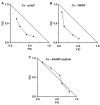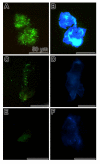Potentiation of the cytotoxic activity of copper by polyphosphate on biofilm-producing bacteria: a bioinspired approach
- PMID: 23203265
- PMCID: PMC3509523
- DOI: 10.3390/md10112369
Potentiation of the cytotoxic activity of copper by polyphosphate on biofilm-producing bacteria: a bioinspired approach
Abstract
Adhesion and accumulation of organic molecules represent an ecologically and economically massive problem. Adhesion of organic molecules is followed by microorganisms, unicellular organisms and plants together with their secreted soluble and structure-associated byproducts, which damage unprotected surfaces of submerged marine structures, including ship hulls and heat exchangers of power plants. This is termed biofouling. The search for less toxic anti-biofilm strategies has intensified since the ban of efficient and cost-effective anti-fouling paints, enriched with the organotin compound tributyltin, not least because of our finding of the ubiquitous toxic/pro-apoptotic effects displayed by this compound. Our proposed bio-inspired approach for controlling, suppressing and interfluencing the dynamic biofouling complex uses copper as one component in an alternative anti-fouling system. In order to avoid and overcome the potential resistance against copper acquired by microorganisms we are using the biopolymer polyphosphate (polyP) as a further component. Prior to being functionally active, polyP has to be hydrolyzed to ortho-phosphate which in turn can bind to copper and export the toxic compound out of the cell. It is shown here that inhibition of the hydrolysis of polyP by the bisphosphonate DMDP strongly increases the toxic effect of copper towards the biofilm-producing Streptococcus mutans in a synergistic manner. This bisphosphonate not only increases the copper-caused inhibition of cell growth but also of biofilm production by the bacteria. The defensin-related ASABF, a marine toxin produced by the sponge Suberites domuncula, caused only an additive inhibitory effect in combination with copper. We conclude that the new strategy, described here, has a superior anti-biofilm potential and can be considered as a novel principle for developing bio-inspired antifouling compounds, or cocktails of different compounds, in the future.
Figures







Similar articles
-
Principles of biofouling protection in marine sponges: a model for the design of novel biomimetic and bio-inspired coatings in the marine environment?Mar Biotechnol (NY). 2013 Aug;15(4):375-98. doi: 10.1007/s10126-013-9497-0. Epub 2013 Mar 26. Mar Biotechnol (NY). 2013. PMID: 23525893 Review.
-
Biofouling and me: My Stockholm syndrome with biofilms.Water Res. 2020 Apr 15;173:115576. doi: 10.1016/j.watres.2020.115576. Epub 2020 Feb 2. Water Res. 2020. PMID: 32044598 Review.
-
Environmentally benign sol-gel antifouling and foul-releasing coatings.Acc Chem Res. 2014 Feb 18;47(2):678-87. doi: 10.1021/ar400240n. Epub 2014 Jan 8. Acc Chem Res. 2014. PMID: 24397288
-
Biomimetic Approaches for the Development of New Antifouling Solutions: Study of Incorporation of Macroalgae and Sponge Extracts for the Development of New Environmentally-Friendly Coatings.Int J Mol Sci. 2019 Sep 30;20(19):4863. doi: 10.3390/ijms20194863. Int J Mol Sci. 2019. PMID: 31574976 Free PMC article.
-
Prevention of marine biofouling using natural compounds from marine organisms.Biotechnol Annu Rev. 2000;6:221-41. doi: 10.1016/s1387-2656(00)06024-5. Biotechnol Annu Rev. 2000. PMID: 11193296 Review.
Cited by
-
Principles of biofouling protection in marine sponges: a model for the design of novel biomimetic and bio-inspired coatings in the marine environment?Mar Biotechnol (NY). 2013 Aug;15(4):375-98. doi: 10.1007/s10126-013-9497-0. Epub 2013 Mar 26. Mar Biotechnol (NY). 2013. PMID: 23525893 Review.
-
A Novel Biomimetic Approach to Repair Enamel Cracks/Carious Damages and to Reseal Dentinal Tubules by Amorphous Polyphosphate.Polymers (Basel). 2017 Mar 25;9(4):120. doi: 10.3390/polym9040120. Polymers (Basel). 2017. PMID: 30970799 Free PMC article.
-
Anti-Biofouling Features of Eco-Friendly Oleamide-PDMS Copolymers.ACS Omega. 2020 May 15;5(20):11515-11521. doi: 10.1021/acsomega.0c00633. eCollection 2020 May 26. ACS Omega. 2020. PMID: 32478240 Free PMC article.
-
Copper ions inhibit Streptococcus mutans-Veillonella parvula dual biofilm by activating Streptococcus mutans reactive nitrogen species.BMC Oral Health. 2023 Jan 28;23(1):48. doi: 10.1186/s12903-023-02738-0. BMC Oral Health. 2023. PMID: 36709299 Free PMC article.
-
Review on Molecular Mechanisms of Antifouling Compounds: An Update since 2012.Mar Drugs. 2017 Aug 28;15(9):264. doi: 10.3390/md15090264. Mar Drugs. 2017. PMID: 28846624 Free PMC article. Review.
References
-
- Batel R., Bihari N., Rinkevich B., Dapper J., Schäcke H., Schröder H.C., Müller W.E.G. Modulation of organotin-induced apoptosis by the water pollutant methyl mercury in a human lymphoblastoid tumor cell line and a marine sponge. Mar. Ecol. Prog. Ser. 1993;93:245–251. doi: 10.3354/meps093245. - DOI
-
- Characklis W.G., Cooksey K.E. Biofilms and microbial fouling. In: Laskin A.I., editor. Applied Microbiology. Vol. 29. Academic Press; New York, NY, USA: 1983. pp. 93–138.
-
- Marshall K.C. History of bacterium-particle interaction studies. Am. Soc. Microbiol. News. 1993;59:377–378. doi: 10.2307/3222553. - DOI
-
- Cooksey K.E., Wigglesworth-Cooksey B. Adhesion of bacteria and diatoms to surfaces in the sea: A review. Aquat. Microb. Ecol. 1995;9:87–96.
Publication types
MeSH terms
Substances
LinkOut - more resources
Full Text Sources
Molecular Biology Databases

